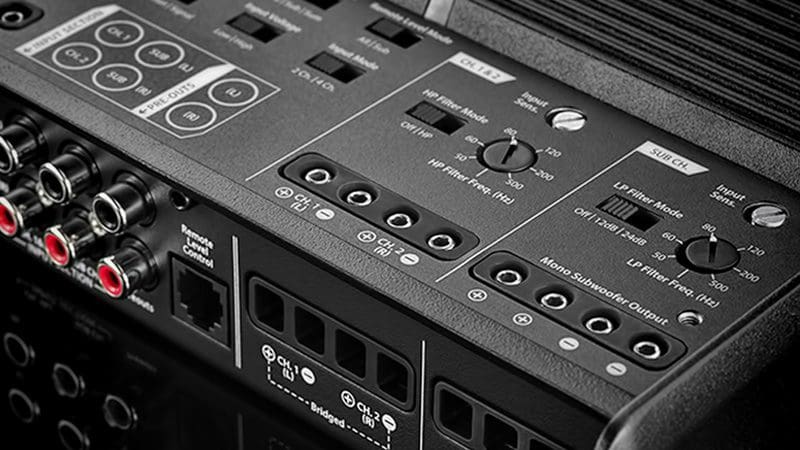 Shopping for a new car audio amplifier is tricky. There are thousands of amplifiers available from at least a hundred car audio companies. Picking the right amp for your system requires balancing an expectation of performance with the cost and features of the amp in question. In this issue of Bang for Your Buck, we are going to talk about car audio amplifier features that will make your audio system sound better and more enjoyable while maximizing your investment.
Shopping for a new car audio amplifier is tricky. There are thousands of amplifiers available from at least a hundred car audio companies. Picking the right amp for your system requires balancing an expectation of performance with the cost and features of the amp in question. In this issue of Bang for Your Buck, we are going to talk about car audio amplifier features that will make your audio system sound better and more enjoyable while maximizing your investment.
Amplifier Channels

Decades ago, you could choose from two- or four-channel amplifiers to power your audio system. Most people used a four-channel amp for the front and rear speakers and a high-power stereo amp bridged to drive a subwoofer or two. The rise in popularity of class D monoblock amplifiers in the ’90s replaced the big stereo amp on the subs with something more efficient, and often more powerful.
No matter how you divvy up the work, you are going to need multiple amplifier channels. Let’s look at two amplifier options for a starting point. A four-channel amplifier is extremely flexible. It can power your front and rear speakers, a set of components and a subwoofer or be dedicated to a set of components using active filters instead of passive networks. It’s rare that a high-quality four-channel amp can’t remain an important part of your system.
Another alternative for an amplifier is a five-channel model. In most cases, these amplifiers provide between 50 and 100 watts of power from the four main channels and 300 to 600 watts from the subwoofer channel. A significant advantage of these amplifiers is that they are housed in a single chassis. This design reduces the need for power and ground distribution blocks and simplifies installation.
Built-in Crossovers
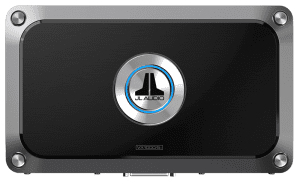
When you are starting out on an audio system upgrade, you will want to take a close look at the crossovers built into the amplifier you are looking at. Assuming you go with a four channel amp, each channel pair will likely include crossovers that can be configured in a high- or low-pass mode. This crossover design makes the amp suitable to drive speakers or a subwoofer. If you plan on using the amp to drive a set of components in an active configuration (something that you should aspire to), then look for crossovers that can reach higher frequencies – in the 4 to 5 kHz range. If you are planning on using a digital signal processor to handle crossovers (another wise aspiration), then the crossover frequencies matter less.
Vehicle Integration Features

Upgrading a modern factory sound system can be tricky. In many applications, the source unit can’t be replaced. This means we need to connect to the radio or the amplifier. If you are planning on keeping your factory source unit in the system, then you will want to choose an amplifier that provides OEM integration features. First and foremost, the amplifier needs to be able to accept a speaker-level signal. Some amplifiers have dedicated connections for high-voltage signals. Other designs allow you to connect the factory speaker wires to the RCA inputs, then press a button to reduce the voltage to something that the amp can handle. A third popular option is amplifiers that include an RCA adapter that has circuitry built into it that reduces voltage.
The second feature you are going to want to look for is remote turn-on detection. Different companies have different names for this feature. In a nutshell, you want the amplifier to turn on when the factory stereo turns on. Amplifiers with automatic remote turn-on detection monitor the input connection for an audio signal or the presence of a DC voltage generated by BTL-type amplifiers in head units.
Remote Level Controls
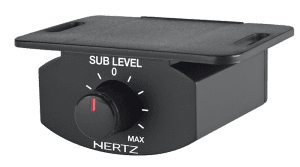 If you are going to use the amp you have chosen to drive a subwoofer, then choose something that includes or has the provision for a remote level control. A remote level control is typically a small metal or plastic box with a knob sticking out of it. You can turn this knob up or down to increase or decrease the level of the subwoofer relative to the rest of the speakers in your car.
If you are going to use the amp you have chosen to drive a subwoofer, then choose something that includes or has the provision for a remote level control. A remote level control is typically a small metal or plastic box with a knob sticking out of it. You can turn this knob up or down to increase or decrease the level of the subwoofer relative to the rest of the speakers in your car.
The best designs are attenuators. This means that at the maximum position, the amp behaves as though the knob isn’t connected. You can turn down the bass level by turning the knob counterclockwise. The reason this design is best lies in the process of how systems are tuned.
Ideally, try to avoid bass boost controls. If you want more bass, then you should want more of ALL your bass, not just those frequencies around 50Hz. Deep bass (below 30Hz) is a lot of fun!
Amplifier Power
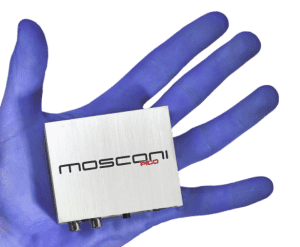
Here’s another tricky subject that requires balancing a lot criteria. First, you can never have too much power available. With that said, depending on your speakers, you may have more power than you’ll ever be able to use. In almost every case, maximum amplifier power determines the size of the amplifier, and vice versa. A 1,500-watt subwoofer amplifier that will operate reliably on a hot summer day isn’t going to fit in the palm of your hand. If you are hoping to upgrade your audio system while keeping the equipment out of sight, then you will need to choose an amplifier that will fit under a seat or in a storage compartment.
In terms of speaker longevity, choose an amplifier that is rated at the same (real) power ratings as your speakers. If the system is set up properly, you shouldn’t have any reliability problems.
Amplifier Installation Accessories
 The second-to-last step in choosing an amplifier for your vehicle is to choose the right installation accessories for it. No, we aren’t talking about chrome shrouds or lighting kits. Your choice of power wire can have a dramatic effect on the performance and reliability of your amplifier. It might sound like a sales pitch, but don’t be stingy with the wiring you choose. A $40 amp kit with 1,000-watts printed on the package may look like a deal, but do you think it will supply power to your amp the same way a $100 kit will?
The second-to-last step in choosing an amplifier for your vehicle is to choose the right installation accessories for it. No, we aren’t talking about chrome shrouds or lighting kits. Your choice of power wire can have a dramatic effect on the performance and reliability of your amplifier. It might sound like a sales pitch, but don’t be stingy with the wiring you choose. A $40 amp kit with 1,000-watts printed on the package may look like a deal, but do you think it will supply power to your amp the same way a $100 kit will?
Think of your power wire like the tires on your car. Inexpensive skinny tires work fine when you are cruising through town on the way to get the groceries. When it’s time to crank up the excitement, these tires fail to provide premium performance. A high-quality tire simply sticks to the road better, and in many cases, lasts longer. Power wire is the same.
Quality Installation and Configuration
 Last and certainly not least is your choice of who will install your amplifier. Cars and trucks aren’t as simple as they used to be. Composite construction, aluminum, high-strength adhesives, computer data networks and BCM-controlled charging systems require that someone with extensive experience work on your vehicle. Assuming that your new car or truck is like every other vehicle they have worked on is a recipe for disaster.
Last and certainly not least is your choice of who will install your amplifier. Cars and trucks aren’t as simple as they used to be. Composite construction, aluminum, high-strength adhesives, computer data networks and BCM-controlled charging systems require that someone with extensive experience work on your vehicle. Assuming that your new car or truck is like every other vehicle they have worked on is a recipe for disaster.
A properly trained and qualified installation technician understands how to mount equipment safely and reliably. They understand the proper process to make electrical connections so that they are efficient and safe. Finally, they have a tried-and-true process that ensures every amplifier is configured to provide maximum performance and reliability. Choose whom you let work on your car very carefully.
Local Help With Car Audio Amplifier Features
When it comes time to upgrade your stereo system, drop into your local mobile enhancement retailer and ask about the latest car audio amplifier features. They will work with you to choose a solution that includes the features you want and provides the performance you desire.
This article is written and produced by the team at www.BestCarAudio.com. Reproduction or use of any kind is prohibited without the express written permission of 1sixty8 media.
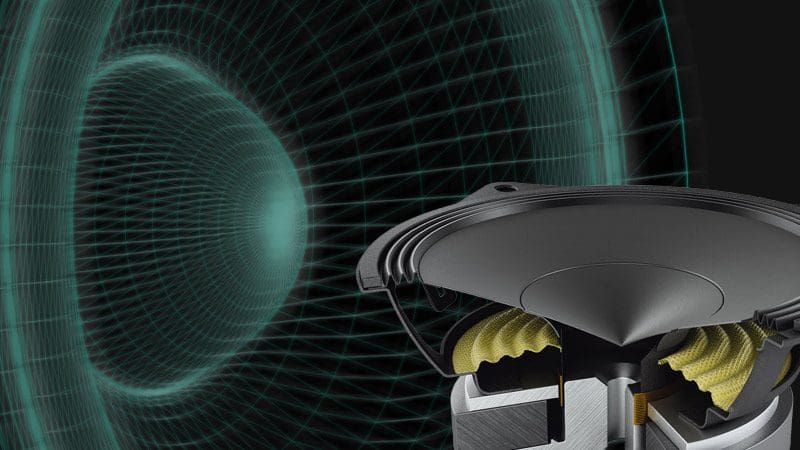 We recently talked about the difference between
We recently talked about the difference between 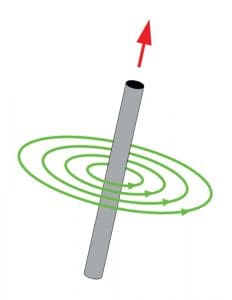
 So, how does inductance cause distortion in a speaker? As you can see in the diagram above when the voice coil winding (in red) is at rest, it is centered on the top plate (in green). As the cone moves down, more of the voice coil is beside the magnet (in blue) and the pole piece (in pink). Conversely, as the come moves outward, less of the cone is near the pole. In a conventional speaker design, the changes in proximity to the steel pole piece cause changes in inductance. As the inductance decreases, there is less opposition to the flow of high-frequency current and an increase in high-frequency performance. Changes in performance based on the position of the speaker cone result in distortion.
So, how does inductance cause distortion in a speaker? As you can see in the diagram above when the voice coil winding (in red) is at rest, it is centered on the top plate (in green). As the cone moves down, more of the voice coil is beside the magnet (in blue) and the pole piece (in pink). Conversely, as the come moves outward, less of the cone is near the pole. In a conventional speaker design, the changes in proximity to the steel pole piece cause changes in inductance. As the inductance decreases, there is less opposition to the flow of high-frequency current and an increase in high-frequency performance. Changes in performance based on the position of the speaker cone result in distortion.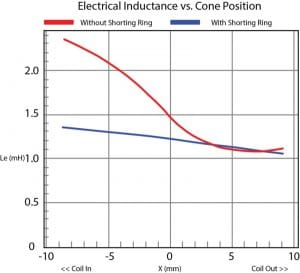
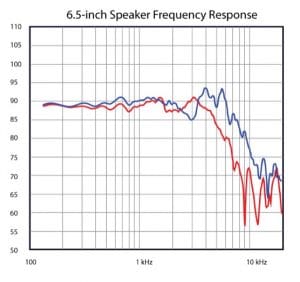 The graph above shows the frequency response of a speaker without a shorting ring (in red) and that of a very similar speaker with a shorting ring (in blue). As is clearly evident, the inclusion of a shorting ring dramatically improves the high-frequency performance of a speaker. Further improvements in linearity can be achieved by including a copper cap on top of the T-yoke.
The graph above shows the frequency response of a speaker without a shorting ring (in red) and that of a very similar speaker with a shorting ring (in blue). As is clearly evident, the inclusion of a shorting ring dramatically improves the high-frequency performance of a speaker. Further improvements in linearity can be achieved by including a copper cap on top of the T-yoke.
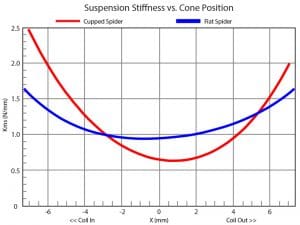
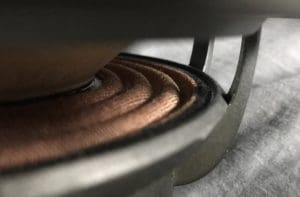
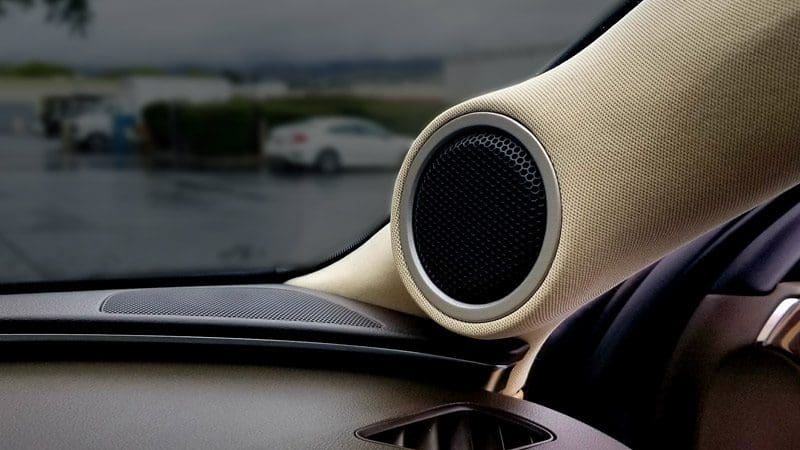 It should be no surprise that your choice of speakers has the biggest impact on the sound quality of your car audio system. With that said, many consumers simply don’t understand what separates one speaker from another in terms of performance and value. In this installment of Bang for Your Buck, we are going to talk about
It should be no surprise that your choice of speakers has the biggest impact on the sound quality of your car audio system. With that said, many consumers simply don’t understand what separates one speaker from another in terms of performance and value. In this installment of Bang for Your Buck, we are going to talk about 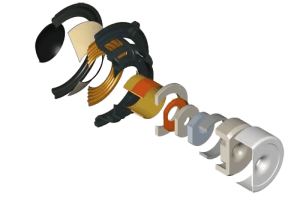
 Cameras are a good analogy for speaker performance. An inexpensive digital camera hanging on a peg in a big-box store will take a picture of anything. You’ll be able to discern the content of the photo without any problem.
Cameras are a good analogy for speaker performance. An inexpensive digital camera hanging on a peg in a big-box store will take a picture of anything. You’ll be able to discern the content of the photo without any problem.
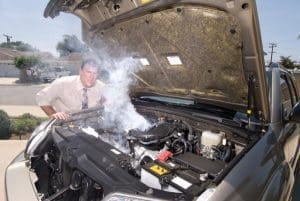
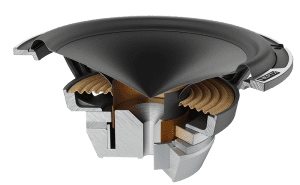
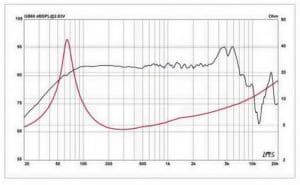 Sadly, very few companies talk about
Sadly, very few companies talk about 
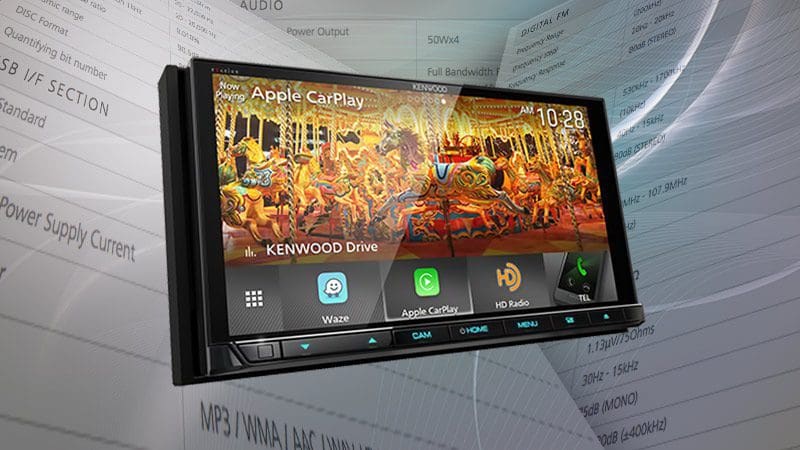 In a recent article, we discussed the features to look for when choosing a new
In a recent article, we discussed the features to look for when choosing a new  In the good old days of car audio, print magazines (remember those?) would publish product test reports that included both listening and bench test information. While at least one these publications still exists, the plethora of numerical information simply isn’t disseminated the way it used to be. That means shoppers have to rely on specifications printed by the manufacturer. In most cases, these numbers are accurate and serve as a good foundation for comparing certain performance characteristics of a product.
In the good old days of car audio, print magazines (remember those?) would publish product test reports that included both listening and bench test information. While at least one these publications still exists, the plethora of numerical information simply isn’t disseminated the way it used to be. That means shoppers have to rely on specifications printed by the manufacturer. In most cases, these numbers are accurate and serve as a good foundation for comparing certain performance characteristics of a product.
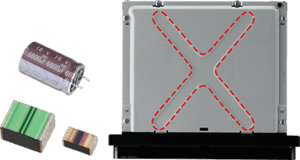
 Interestingly enough, pre-amp output voltage is tied directly to the signal-to-noise ratio measurement of the source unit and the
Interestingly enough, pre-amp output voltage is tied directly to the signal-to-noise ratio measurement of the source unit and the 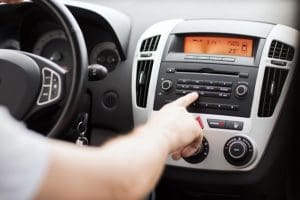 Over the past few years, the perceived quality of radio tuners in
Over the past few years, the perceived quality of radio tuners in 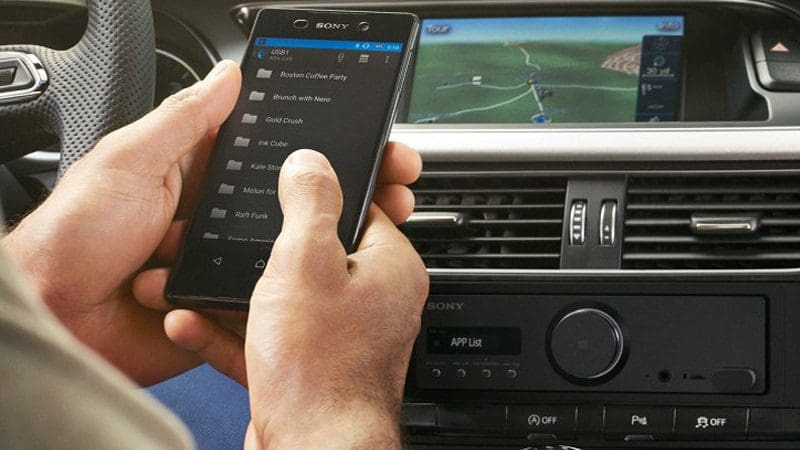 A long time ago, a friend of mine told me always to ask a salesperson what I would get if I spent 10 percent to 15 percent more on an item I wanted to purchase. At the time, the discussion was related to a large tube-style television. Let’s say the TV I was looking at sold for $800. If stepping up to a $900 model resulted in a better picture, or the addition of a feature that I would enjoy, then it would be worth the investment. In the mobile electronics industry, or perhaps consumer electronics in general, few customers ask, “What do I get for a little bit more?” This article will be the first of many that discuss the true performance features of mobile electronics products. For this article, we’ll look at better source units. What do you get when you spend more and how you benefit from those feature or performance upgrades?
A long time ago, a friend of mine told me always to ask a salesperson what I would get if I spent 10 percent to 15 percent more on an item I wanted to purchase. At the time, the discussion was related to a large tube-style television. Let’s say the TV I was looking at sold for $800. If stepping up to a $900 model resulted in a better picture, or the addition of a feature that I would enjoy, then it would be worth the investment. In the mobile electronics industry, or perhaps consumer electronics in general, few customers ask, “What do I get for a little bit more?” This article will be the first of many that discuss the true performance features of mobile electronics products. For this article, we’ll look at better source units. What do you get when you spend more and how you benefit from those feature or performance upgrades? It should be no surprise that the majority of
It should be no surprise that the majority of 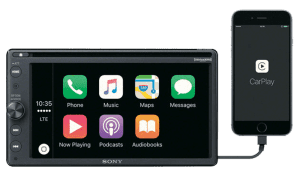 When you are shopping for a new receiver, you may want to consider asking about Apple CarPlay and Android Auto. These smartphone solutions use voice recognition technologies to make performing common tasks easier and safer. You can send a text message, choose the music you want to listen to or get navigation directions, all by simply talking to your radio. These technologies have associated hardware requirements put forth by Apple and Google, and include technology licensing costs. As such, they cost extra to purchase, but they are well worth the investment.
When you are shopping for a new receiver, you may want to consider asking about Apple CarPlay and Android Auto. These smartphone solutions use voice recognition technologies to make performing common tasks easier and safer. You can send a text message, choose the music you want to listen to or get navigation directions, all by simply talking to your radio. These technologies have associated hardware requirements put forth by Apple and Google, and include technology licensing costs. As such, they cost extra to purchase, but they are well worth the investment. If you are passionate about your music, look for a source unit that includes crossovers. The ability to filter the signals created by the source unit will let you add a subwoofer to improve the performance of your audio system dramatically. Having simple bass, midrange and treble controls may be adequate to let you adjust your sound system. More elaborate
If you are passionate about your music, look for a source unit that includes crossovers. The ability to filter the signals created by the source unit will let you add a subwoofer to improve the performance of your audio system dramatically. Having simple bass, midrange and treble controls may be adequate to let you adjust your sound system. More elaborate  Hooking things up to your radio is part of the fun of upgrading your vehicle. The most basic of source units may include Bluetooth, a USB port, an auxiliary input, a backup camera connection and preamp outputs for external amplifiers. As you move up through a brand’s models, you’ll discover functions like SiriusXM compatibility, multiple USB connections, support for more than one phone, multiple camera inputs, multiple video inputs, HDMI input, multi-zone outputs and more. Do your homework before you go shopping. Decide what functions you want before you leave the house. Your retailer can start with that to help you choose a solution.
Hooking things up to your radio is part of the fun of upgrading your vehicle. The most basic of source units may include Bluetooth, a USB port, an auxiliary input, a backup camera connection and preamp outputs for external amplifiers. As you move up through a brand’s models, you’ll discover functions like SiriusXM compatibility, multiple USB connections, support for more than one phone, multiple camera inputs, multiple video inputs, HDMI input, multi-zone outputs and more. Do your homework before you go shopping. Decide what functions you want before you leave the house. Your retailer can start with that to help you choose a solution.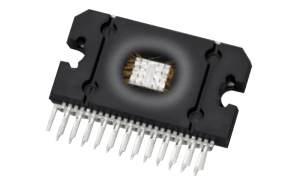
 Another important consideration is digital media compatibility. Most systems will play MP3 and WMA audio files. As you step up in features, you gain support for AAC, WAV and FLAC files. Upgrading even further gets you support for high-resolution audio formats that offer audio content beyond 20kHz. The second consideration for digital media compatibility is video. Determining whether a source unit will play video files is the first step. Second is the type of files. MPEG and WMV file playback is found on mid-level systems. Premium solutions add H.264 formats and often support MKV containers.
Another important consideration is digital media compatibility. Most systems will play MP3 and WMA audio files. As you step up in features, you gain support for AAC, WAV and FLAC files. Upgrading even further gets you support for high-resolution audio formats that offer audio content beyond 20kHz. The second consideration for digital media compatibility is video. Determining whether a source unit will play video files is the first step. Second is the type of files. MPEG and WMV file playback is found on mid-level systems. Premium solutions add H.264 formats and often support MKV containers. Almost every multimedia receiver includes a steering wheel control interface connection. This connection allows your installer to configure an external interface that will allow the audio adjustment buttons on your steering wheel to work with your new radio. If you are looking for advanced integration, the iDatalink Maestro RR interface allows bidirectional communication with the CAN bus in your vehicle and many applications, as well as compatibility with factory backup cameras, UBS ports and infotainment solutions like Uconnect and Ford Sync. Depending on the vehicle and trim level, climate settings can also be controlled through the Maestro RR.
Almost every multimedia receiver includes a steering wheel control interface connection. This connection allows your installer to configure an external interface that will allow the audio adjustment buttons on your steering wheel to work with your new radio. If you are looking for advanced integration, the iDatalink Maestro RR interface allows bidirectional communication with the CAN bus in your vehicle and many applications, as well as compatibility with factory backup cameras, UBS ports and infotainment solutions like Uconnect and Ford Sync. Depending on the vehicle and trim level, climate settings can also be controlled through the Maestro RR.